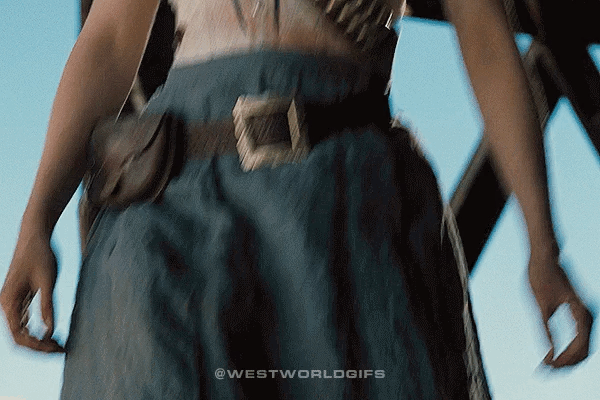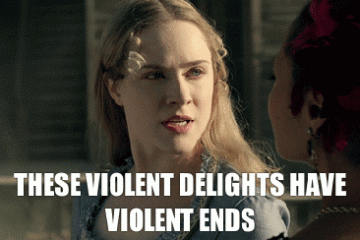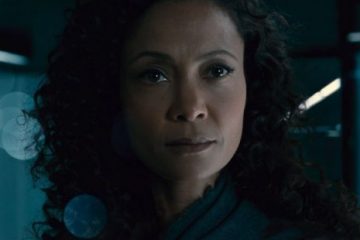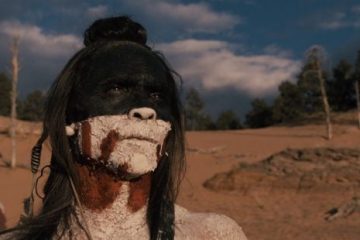Lots of people have died on Westworld. Some multiple times. Yet no episode has focused so much on death as last night’s “Vanishing Point.” It was a detailed examination of suicide – who commits it, who doesn’t, and why. I know the show’s creators couldn’t have predicted our real-world news cycle – the high profile deaths and raising rates of suicide across the US – but it’s hard to imagine a more triggering subject and corresponding cultural moment, so please read (and watch) on with care.
For long, the death of William’s real-life wife has haunted the show (her name is Juliet in case you were wondering if her death was avoidable). The penultimate episode of season two focuses on her last night – revealing a woman struggling with addiction fed by recognizing the evil in her husband that no one else discerns. We see the unhappy couple at a gala, thrown in honor of William’s philanthropy. Juliet gets drunk. Makes a scene. Keeps making a scene when she gets home. Grace their daughter sees it. She thinks they should send Juliet to rehab, going so far as getting their doctor to agree to conscript Juliet to involuntary treatment. For his part, William seems to take perfect care of Juliet, even confessing his concern that darkness may be at his core. But it is too late. Juliet kills herself.
Why? Well, she finds the profile the park has of William (and which Dr. Ford gives to him earlier that night as some sort of warning). And on that profile is the “Man in Black” – the evil man who rapes and murders and kills human-looking robots for fun. Juliet has found out that she’s right about her husband. The successful businessman and philanthropist the world of humans knows is only half the story. This other person lies within him. This knowledge is the last thing she learns before killing herself.
This question – of who William really is: the Man in Black of the park or William the rags-to-riches success story – has also been at the heart of Westworld. It animated much of the first season. In this episode, we see William completely embody the Man in Black character, confusing reality and Ford’s game to the point of not only killing real people but also murdering his own daughter. When William learns that the corpse in front of him is not a host but the real Grace, he too contemplates suicide. Perhaps he realizes that he didn’t know his daughter or wife as well as he thought. Perhaps he realizes he doesn’t know himself as well as he thought. But regardless, he chooses to live, to fight on.
"You don't just think I'm a host. You think everything here is for you."
William's daughter just explained rich white man-ism in a nutshell. #Westworld #SetsInTheWest
— Oz-imus Prime (@letsgetfree13) June 18, 2018
I have seen the show as Dolores’ story (“Evan Rachel Wood” is the first name in the credits after all) but I am remiss if I cannot see how Dolores’ story is also William’s. This episode finds them in near perfect parallel as Dolores’ partner Teddy also takes his own life. And unlike all the other times Teddy has died, this time it is for real and of his own choosing. With the backups gone, he cannot be resurrected and he kills himself looking for a final ending, not a momentary way out.
Like William and Juliet’s, Dolores and Teddy’s union has been a path to ruin. Dolores and Teddy may have spent decades as thwarted lovers, reenacting an easy stage of their relationship but when they start to chart their own course, things get more difficult. Dolores isn’t just the sweet farm girl any more. She’s also Wyatt and the Deathbringer, the mercenary, revenge wrath who is willing to destroy so much to complete her mission.
In an earlier episode, Teddy doesn’t kill some men after Dolores orders him to. Dolores observes Teddy’s disobedience and combines it with his many other moments of compassion to make the case that he is “too good for this world.” And what does Dolores do? She changes him. She uses her power to alter his programming, making him more ruthless, less principled, and more quick to kill. Yet, something of the original Teddy remains. This episode, we see Teddy reenacting that scene – this time, letting a member of Ghost Nation go. Now, you may argue that the escaping Wanathon uses some Maeve-esque command to still Teddy’s hand. And maybe that’s true. Yet, with Wanathon out of range, Teddy seems relieved. He didn’t want to kill him.
THIS IS NOT HOW YOU BREAK UP WITH GIRLS, TEDDY! #Westworld pic.twitter.com/ajaA3553Tk
— Titan Uranus (@djhkang) June 18, 2018
In his final scene, Teddy explains to Dolores that he’d protect her to his dying day but he can protect her no longer. He kills himself. Like Juliet, seeing the darkness in his beloved is too much for him. It has changed him and he cannot live with who he has become. Just before raising the gun to his temple, Teddy asks, “What’s the use of surviving if you become just as bad as them?”
So the question is, has Dolores become “just as bad” as the Man in Black? Are they the same now? They both head to the Valley Beyond to destroy the data on the human guests. They both have lost their loves to suicide (while the same music plays in the background). They both grapple with inhabiting opposite personas – one good, one evil. They both kill. They both suffer. In the teaser for the season two finale, it looks like they confront each other (William holding a gun to her head) and team up (riding across a deep valley together). Has this whole thing been an exercise in reuniting these two old flames? Will they find love and peace in each other’s arms? It’s hard to imagine.

For unlike Maeve who defies the script set for her (whether in loving Hector or seeking her daughter) or Bernard who has finally learned to stand up for himself (digging and deleting Dr. Ford out of his programming) or Akecheta who teaches himself self-awareness (we missed you this episode), Dolores and William are stuck. They do not grow or change or defy their destinies. They reenact them. Again and again and again and again…
So while Dolores and William (so far) survive the loss of their partners, they do not have to represent what it is to be close to someone who commits suicide. Those of us in the real world are not on loops. We can change and love and grow. The headlines will come and go but let us stay committed to building a world where more of us are supported and cared for. Let us build a world that shows the goodness in the human condition and not just the capacity for evil. Let us build a world based in the fundamental dignity of all people.
This post originally appeared on therepresentationproject.org.




0 Comments